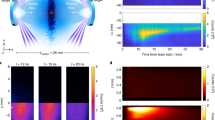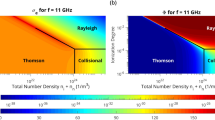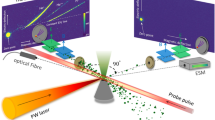Abstract
WE have previously described a collisionless shock with low Alfvén Mach number (MA), which propagates perpendicular to a magnetic field1–3. The shock is produced by the radial compression of an initial hydrogen plasma within a linear z-pinch. The initial plasma is 85 per cent ionized with electron density = 6.4 × 1020 m−3, and temperatures = = 1.2 eV, and is in an axial magnetic field = 0.12 Wb m−2. The shock propagates radially inwards through the initial plasma with a steady velocity Vs = 240 km s−1 (MA = 2.5), and with a steady structure of width Ls = 1.4 mm and compression ratio F = 2.5. The measured electron temperature behind the shock, = 44 eV, implies a resistivity within the shock about two orders of magnitude greater than the classical collisional value4. This demonstrates the collisionless nature of the shock. The effective mean resistivity (η̄), obtained from the power balance equation  corresponds to a colision frequency
corresponds to a colision frequency  The currently accepted theories of such shocks3,5,6 invoke ion wave turbulence7 to explain the structure and collisionless heating.
The currently accepted theories of such shocks3,5,6 invoke ion wave turbulence7 to explain the structure and collisionless heating.
This is a preview of subscription content, access via your institution
Access options
Subscribe to this journal
Receive 51 print issues and online access
$199.00 per year
only $3.90 per issue
Buy this article
- Purchase on Springer Link
- Instant access to full article PDF
Prices may be subject to local taxes which are calculated during checkout
Similar content being viewed by others
References
Paul, J. W. M., Holmes, L. S., Parkinson, M. J., and Sheffield, J., Nature, 208, 133 (1965); Seventh Intern. Conf. Phen. in Ionized Gases (Belgrade), 2, 319 (1965).
Paul, J. W. M., Goldenbaum, G. C., Iiyoshi, A., Holmes, L. S., and Hardcastle, R. A., Nature, 216, 363 (1967).
Paul, J. W. M., Scottish Universities Summer School on Plasma Physics, Edinburgh, August 1968 (Oliver and Boyd, in the press).
Spitzer, L., and Härm, R., Phys. Rev., 89, 977 (1953).
Sagdeev, R. Z., Rev. Plasma Physics, 4, 23 (1966).
Krall, N., and Brook, D. L., Phys. Fluids, 12, 347 (1969).
Kadomtsev, B., Plasma Turbulence (Academic Press, 1965).
Bekefi, G., Radiation Processes in Plasmas (Wiley, 1966).
Paul, J. W. M., Daughney, C. C., and Holmes, L. S., A. P. S. Conference on Plasma Instabilities in Astrophysics, Asilomar, October 1968).
Rudder, R. R., and Back, D. R., J. Opt. Soc. Amer., 58, 1260 (1968).
Denisee, J. F., and Delcroix, J. L., Plasma Waves (Interscience, 1963).
Thompson, W. B., and Hubbard, J., Rev. Mod. Phys., 32, 714 (1960).
Stringer, T. E., J. Nucl. Energy, C., 6, 267 (1964).
Author information
Authors and Affiliations
Rights and permissions
About this article
Cite this article
PAUL, J., DAUGHNEY, C. & HOLMES, L. Measurement of Light scattered from Density Fluctuations within a Collisionless Shock. Nature 223, 822–824 (1969). https://doi.org/10.1038/223822a0
Received:
Issue Date:
DOI: https://doi.org/10.1038/223822a0
This article is cited by
-
The structure of the earth’s bow shock
La Rivista del Nuovo Cimento (1973)
-
Spectroscopy of laboratory plasmas
Space Science Reviews (1972)
-
Instabilit�ten und kollektive Energiedissipation in Plasmasto�wellen
Die Naturwissenschaften (1971)
Comments
By submitting a comment you agree to abide by our Terms and Community Guidelines. If you find something abusive or that does not comply with our terms or guidelines please flag it as inappropriate.



